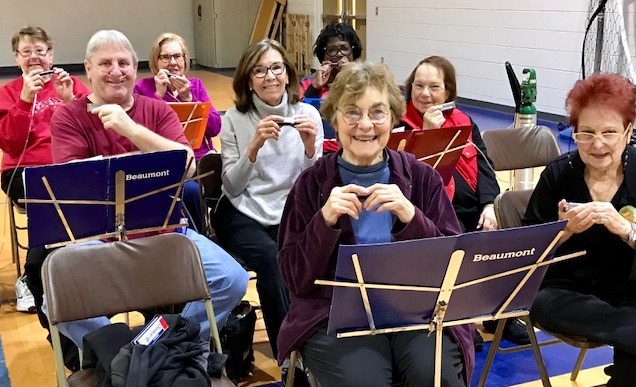
AARC Member Teena Culhane, BS, RRT of Beaumont Hospital in Michigan helped create a Harmonicas for Health class within the hospital’s pulmonary rehab program last November. The group is called the Half-Notes and they performed for the very first time at their patient holiday party in December. According to Culhane, the group practiced “one day per week all year long in preparation of this performance, and they were absolutely amazing!”
We asked the group from Beaumont to share their experiences with the Half-Notes and offer tips for other RTs who may be interested in starting a similar group in their area. Here’s their story.
The Half-Notes
by Kathy Rawlings, music leader, and Teena Culhane BS, RRT
Have you ever heard the joke about what it takes to become a good harmonica player? They say it takes 2% talent, 2% dedication and 96% hot air. I disagree with some of those percentages, but I do know it takes a lot of air. That is what makes it such a great activity for COPD patients.
Inhaling and exhaling are the most important elements in harmonica playing (and actually in life). As it turns out, it’s all about the diaphragm. It only makes sense to keep that muscle strong, and even more so if you are suffering from a pulmonary problem. When you play harmonica, you are naturally working that muscle. As you move from the middle of the harmonica to the higher notes and down the harmonica to the lower notes it gets harder—I call it resistance training for the diaphragm. Harmonica’s work much like the Breather (a small hand-held device we use for diaphragm resistance training), but much more fun.
We decided to start up a harmonica program last year to give our patients another opportunity to increase diaphragm strength and to practice controlled breathing. Our first class was held in February 2017. It started out with a lot of enthusiasm and that excitement has continued to grow. Every Tuesday, 12 to 15 harmonica players get together here at Beaumont Hospital to work on songs, technique, timing and sometimes special effects. As a group we’ve worked on techniques to help with shortness of breath while playing. I’ve suggested to my students that if you’re playing harmonica to help increase lung strength, play 2-3 times a day for about 10 minutes (like the Breather). If you’re playing the harmonica to “play” the harmonica and increase strength, then play as much as you want!
So, how do you start a harmonica program? I purchased the “Harmonicas for Health” instructor’s kit from the COPD foundation. There you will find plenty of great instruction, songs and ideas. Outside of the kit, it was helpful that I already had some experience. I’m a guitar player and was in the process of learning to play harmonica at a local folk music society in my area. Once I received the thumbs up from my manager to start a harmonica group, I hit the internet. There are several very good harmonica instructors online, and several are free! After you get the basics down you’re on your way to being able to share it with your students. You can find music by visiting harmonica tabs sites online. There you’ll be able to find and print hundreds of songs. You’ll also find other players online who are willing to teach techniques and the ‘fancy stuff’ that we love to hear (and play) on the harmonica. I think there is an element of learning as you go, every program is a little different and you have to fine tune it to fit the needs of your students.
The Half-Notes have been playing together for almost a year now, and I’m pretty proud of this group. They are learning to play (getting good as a matter of fact), having fun, making friends and working their diaphragms. I have noticed that many of my students can hold notes longer, and play drawn notes stronger. Over time, we are also able to increase the tempo of many of our songs, and it’s all happening while we are really enjoying our time together. The Half-Notes put on a small performance at our annual Christmas party. We really had a great time and so did our audience! We’re thinking of taking our show to the halls by playing for other patients in our rehab area.
If you are interested in starting a harmonica Group, don’t be discouraged because you don’t think you know enough to teach it. The information you need is quite obtainable. The harmonica is an instrument that is very forgiving—it can sound good even when you make mistakes. I know my students are really benefitting from it.
I’ll leave you with this: why do harmonica players smile so much? It’s because they’re harmonica players.